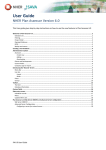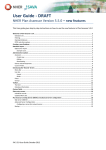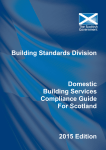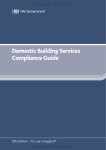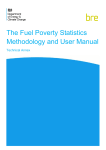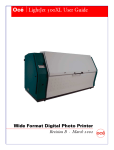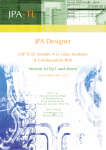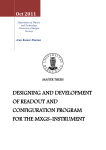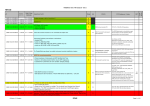Download User Guide - Plan Assessor
Transcript
User Guide NHER Plan Assessor Version 6.1 This User guide gives step by step instructions on how to use the new features in Plan Assessor 6.1 Welcome to Plan Assessor 6.0 .......................................................................................................................................... 2 Database List ......................................................................................................................................................................... 2 Filtering ................................................................................................................................................................................. 2 Project folder ........................................................................................................................................................................ 3 Opening Databases ............................................................................................................................................................... 3 PCDF ...................................................................................................................................................................................... 3 Backup and restore ............................................................................................................................................................... 3 Importing a 5.5 SQL database ............................................................................................................................................... 4 Database archiving ................................................................................................................................................................ 5 Creating a new Database .................................................................................................................................................. 6 Administration options .................................................................................................................................................... 6 Assessors ............................................................................................................................................................................... 7 Create new ....................................................................................................................................................................... 7 Editing .............................................................................................................................................................................. 7 Deactivating ..................................................................................................................................................................... 8 Clients and Developments .................................................................................................................................................... 8 Custom Fields ........................................................................................................................................................................ 8 Company Logo on report ...................................................................................................................................................... 9 Introducing the ‘Records’ Screen ...................................................................................................................................... 9 Menu Bar ............................................................................................................................................................................ 10 Icon bar ............................................................................................................................................................................... 10 Layout ............................................................................................................................................................................ 11 Mode .............................................................................................................................................................................. 11 Filters .................................................................................................................................................................................. 11 Groups ................................................................................................................................................................................ 12 Toolbar............................................................................................................................................................................15 The Grid .............................................................................................................................................................................. 17 Database Information ......................................................................................................................................................... 18 Custom Fields ..................................................................................................................................................................18 Data entry screens ..........................................................................................................................................................18 Individual records ............................................................................................................................................................... 19 Notes ................................................................................................................................................................................... 19 Updated Menu bar.............................................................................................................................................................. 20 Plan Assessor and SQL Server 2008 R2 and advanced server configuration ......................................................................21 SQL Server 2008 R2 ............................................................................................................................................................. 21 Advanced Server Configuration .......................................................................................................................................... 21 Configuring a server for network access ........................................................................................................................ 22 PA 6.1 User Guide User Guide Welcome to Plan Assessor 6.1 Plan Assessor 6.1 incorporates the changes to SAP2012, Part L 2013 (England) and Part L 2014 (Wales) as well as introducing a number of new features to increase the usability of the software. In December 2012 Plan Assessor changed from using Microsoft Access to use Microsoft SQL server to store your records. This guide also contains some of the new features that were introduced as a result of this change. Individual database files are now managed by the SQL Server implementation so Plan Assessor connects to this server automatically and then displays the list of databases that are being managed. In most cases the SQL Server will be on a users individual PC and no further considerations need to be made. Database List The first updated screen is the “Welcome” screen. There shows a list of all of your Plan Assessor 6.0 databases. Databases are no longer managed outside of Plan Assessor and so individual Access files do not need to be placed in any specific folder. NB: The SQL databases do still have a “physical” location and that location can be updated using SQL Server Management Studio. However, doing this could affect some of the new features and so it is not recommended. Filtering A quick filterable Reference can be assigned to a database. It is recommended that a small quick Ref is used to help organise similar databases together. Use of an assessor name, a developer or the year the database is associated with are all tested methods but what you select can be down to individual workflow. Use the dropdown on the right to filter a particular database “set”. Only those with a particular reference will be displayed. PA 6.1 User Guide Project folder This allows you to link a database to a location on a hard-disk drive or network, so that you can relate your database to relevant documents e.g. architects plans, specification. You can specify the location from the Welcome / Select Database screen, choose the ‘Database’ drop down menu and go to Change Project Folder. The location you choose will be used as the starting point for operations within Plan Assessor such as Import & Export, Save PDFs, Backups etc. The folder will have the same location for everyone who connects to that database Opening Databases To open a database, highlight the particular database. Ensure that an assessor is selected then either double click the database or click open in the top right. PCDF The Products Characteristics Database file (PCDF) can be updated directly from the Welcome Screen, via the Server dropdown. Other features on these menus allow you to change the currently connected server and to access the Admin screens. Backup and restore You can backup your database via the Database menu on the Select Database screen. Here you will find 2 options Backup and Restore. PA 6.1 User Guide Clicking Backup will prompt you to choose the location that you wish the backup to be saved to. By default it will point to the location of your Project Folder but you can alter this by clicking Change. When you click Start it will backup the database to a .BAK file. Clicking Restore will allow you to restore a .BAK file into Plan Assessor. As well as using the backup/restore to secure your data it can be used to transfer databases between assessors in the same way that you could do with Access database files. Importing a 5.5 SQL database Under the Database option you will find the option to Import a 5.5.x SQL Database. Clicking this will launch the database importer. You then have the option of searching your local computer for a SQL server or manually typing the address. If you ask the importer to Search your local machine for instances of SQL then these will be displayed in the dropdown list. The version 5.5 instance will usually be called PLANASSESSOR. Once you have selected the instance name the list of databases will be populated in the table below. You can then select the database(s) that you wish to bring across to version 6.1 then click Import. PA 6.1 User Guide The database will then be imported into version 6.1. The name of the database will be suffixed with (6.1). Database archiving It is possible to archive a database. This means that it will be hidden from the main Select Database screen. This is useful if you work with a large number of databases; when you are finished with a database you can Archive it and remove it from the Select Database screen. The options for Archiving appear under the Database menu: You can Archive a database by clicking Archive Selected Database To view your Archived databases, click Show Archived Databases To Unarchive a database, click Unarchive Selected Database Archiving a database will not delete or automatically backup the database. PA 6.1 User Guide Creating a new Database Click New in the lower left to create a blank new database. Enter the Name of the database. It is also recommended that a brief quick search Reference is also used. If databases already exist the Ref dropdown will display References that have already been used. A longer Description can also be used to help differentiate databases between projects. Once the database has been created it will appear in the Database List on the Welcome screen. Administration options Having control over Assessors developments clients and custom fields has never been easier with an updated Administration area. The Administration screen can be reached from the Server drop down on the Welcome screen, the Admin button in the lower right or by clicking Admin when within Record Manager (see later section of the user guide). In an individual Record the individual administration pages can be reached using the +’s adjacent to the Assessor, Client and Development fields on the Job Details screen. PA 6.1 User Guide Assessors An assessor is important as it is the “log-in” used to access Plan Assessor. In future versions more security may be added, making the Assessor an even more important feature. For now it contains all the relevant details that appear on the Building Regulation Analysis output. Create new Each page has a Create button. Click this to add a new item. For an Assessor you then need to enter: Assessor Number: Using the last 4 digits of your NHER number or as it appears on your license key is recommended. Title, First name and Surname Editing Editing can either be done directly from the Administration screen by “second clicking” (Click once to highlight the Assessor and then click a second time on a particular field to edit the text in this field. If more control is required then use the Edit button. PA 6.1 User Guide Deactivating When an assessor is no longer needed then it can be deactivated. This could be because the Assessor leaves the company or the details are no longer required to be displayed. Rather than deleting the Assessor – which would make any details in a record become blank, the Assessor is deactivated. This means they will no longer be available to select as an Assessor to assign to a job or log-in with. However the name of the Assessor will remain within the Records until changed to a different Assessor. If you de-activate an Assessor and want to re-enable, say to better filter a previous workers jobs, set the Show inactive Assessors field to Yes. Inactive Assessor will be in italics. Highlight and then click Re-activate to enable them to be used again. Clients and Developments All the above features for Assessors are available for the other options in Administration screen tabs e.g. Clients and Developments. Custom Fields Custom Fields are additional fields that you as the user can create to match your own working practices. For example, you may have a job reference that you want to store within each URN. PA 6.1 User Guide Company Logo on report It is now possible to put your company logo onto the reports produced from Plan Assessor 6. You have the choice of choosing a ‘local’ logo (stored on your PC) or a ‘shared’ logo (which can be used by all assessors accessing the server). The size of the logo should be 400px by 100px and can be adjusted by double clicking on the logo once selected. There are various zooming options which can be chosen to help you edit the logo. Note, if the area selected isn’t 400px by 100px then the logo may appear stretched or squashed. Introducing the ‘Records’ Screen The ‘Records’ screen or Record Manager is the first screen to appear once a database has been loaded: There are 7 basic areas to the screen. [top to bottom] 1. The menu bar 2. Icon bar 3. Filters 4. Groups 5. Quick Toolbar 6. Records ‘Grid’ 7. Database information PA 6.1 User Guide The main parts of the Screen are (a) the Grid that displays an overview of the records (b) the filters and (c) Groups which help to organise your records. Further information on Groups can be found in the Groups user guide. Groups are a more flexible version of the Projects feature in previous versions of Plan Assessor Menu Bar The Menu bar has been updated to ensure that all functionality available in the icon bar, tool bar and groups can be access from the menu bar. It also includes some features associated with an individual record. For example you can view a report for a record, without loading the record into the traditional Plan Assessor individual record interface: Highlight a record Go to Reports on the Menu bar Select a Report Save or print the report Close the report. Another record can be highlighted and a new report generated without reloading the record More importantly you can issue an EPC or address match on an individual record without opening it. The File menu contains many commands such as issue EPC, Save as new version and Export to XML. These actions are only available with a single record highlighted in the Grid. Icon bar The icon bar gives quick access to some features using clear icons to symbolise their functions From left to right the functions are: Create new record Open currently highlighted record (new)Toggle between “batch” and “classic” layout (new)Toggle between Records and Templates (new)Edit Administration settings (new)Select a different database (new)Update the PCDF (new)Check NES one balance PA 6.1 User Guide Direct link to NES one Plan Assessor News Page All these features are also available from the Menu bar under the different headings – for example Balance is under File, Check Balance. Layout This button Changes the main record manager page to a “classic” view. This removes the batch processing toolbar and the groups pane. This can make it easier to find records and is a more traditional view comparable to previous Plan Assessor versions ‘Open’ screen. Mode This switches to template mode. Here you can view, create, edit and organise templates. Please see the Template section in the helpfile for further information. Filters To add a filter press the + To remove the filter click X To edit a filter double click on the filter text It’s possible to add an automatic filter based on the assessor selected from the Select Database screen. This can be useful if multiple assessors are accessing the same database. You can enable this feature in Options via the Applications menu. PA 6.1 User Guide Groups The Groups facility in NHER Plan Assessor is a useful tool to organise your records within NHER Plan Assessor. This article shows two examples of how records can be organised using Groups to effectively manage sets of records and to perform actions on the organised groups. Example one: organise a number of records into manageable chunks or group similar records for quick access to view or edit. Example two: use as workflow management to separate records that are at different stages in the development process. Groups can be used in different ways; however, basically they are folders containing ‘shortcuts’ for a selection of records. Please be aware that if you choose to delete a record whether it is contained in a group or otherwise, it will be deleted. Example One: Organising Records First, you will need to create a group and in order to do this, load the Records screen and use the area on the left hand side of the Records screen which shows the GROUPS options that are available. Groups have two aspects, i.e. a Heading Name and a Group Name; a heading can contain a number of separate groups. Using the plus button in the top left you can create a heading and the first group within this heading. Now you have three options: 1. If you want to add all the records displayed in the view to the group which you are going to create, then option 1 can be used; 2. If you already have a set of records selected and would like to add only the selected records to the group, then option 2 can be used; PA 6.1 User Guide 3. Otherwise option 3 will create an empty group. To illustrate the first example: Firstly, create an empty group called Plummer Court and assign the heading ‘Quick Find’. Next, choose the records which you want to add to the Group; to do this use the Filter ribbon. (Use the keyboard and mouse to select the records that you want to include.) You can then drag and drop your selection and place it into the Unassigned Group. Alternatively, you can click Group on the menu bar and select Copy to Group, this will allow the records to be accessed from ALL and the Group created. You now have two ways of accessing the Plummer Court records, either by using filters on ALL or by clicking on the Group. Filters display newly created records automatically, whereas Groups are fixed, i.e. any additions will need to be manually added. Example Two: Workflow management To control the workflow on a set of jobs you can select the heading to organise the project, and then individual group names under the headings to create sub-categories. In our example the Heading is ‘Plummer Court’ and the default ‘Unassigned Group’ name was used. Again, you will need to place the relevant records into the Group: one way of selecting records, is to hold down the Ctrl key and then click to highlight just the required records. Remember, you will need to have the ALL Group option selected to see all your records. The Plummer Court, Unassigned Group now contains all relevant properties. If, for example, the client asks for EPCs for the ground floor flats and provides confirmation of air pressure tests for those flats only, you may want to separate out those records. You can start this process by creating a second Group: · Highlight the Heading ‘Plummer Court’ and then click the green plus button. The heading field will be auto-filled and you can name the new Group EPC; PA 6.1 User Guide · Then drag the highlighted records that you want to produce an EPC for, to the newly created Group called EPC. This time the drag and drop action will move the shortcuts of the records from the Unassigned group to the EPC Group. As you perform the drag and drop a ‘Move’ icon will appear underneath the mouse. This means that those records will no longer be accessible using Unassigned Group but you will be able to access them from EPC Group instead. The EPC Group will now display the three highlighted records, while the Unassigned Group will only display the seven records that you did not move. If the Group you are dragging to is under the same heading and you hold the Ctrl key while dragging and dropping, this will change the icon under the mouse to display ‘Copy’ and will allow the record to still be accessible from both Groups. If the Group you are dragging to is under another heading, the record will be accessible from both Groups unless you hold down the Ctrl key. In this case the ‘Copy’ icon under the mouse will change to ‘Move’ and the record will only be accessible from the Group you drop the record into. Removing records from a group If you choose to delete a record it will permanently be removed from your PA 6.1 User Guide database. Note that removing the shortcut to a record from a Group is not the same as deleting. To remove a record from a Group, highlight the associated records then drag them to the bottom of the Groups panel. You should see a trash icon appear. The records will no longer be accessible from the group but will still be accessible from ALL and other Groups as appropriate. Conclusion Using the Groups tool in NHER Plan Assessor can give you a flexible and efficient way to administer your records. Used in conjunction with Filters, this feature can assist in organising and searching for your data, which you can customise to fit your own requirements. Toolbar Icons and dropdowns allow functions to be carried out on single or a set of highlighted records from the Grid. There are 7 main functional areas on the toolbar, from left to right: Export Export provides 2 options to export the key Results to a spreadsheet or export the XML (this function is the same as going to File menu, then export). If multiple records are selected then all selected Records’ results will be output to a spreadsheet. The Spreadsheet has been updated to decrease allowance on Microsoft Office and so now the default format is CSV rather than Excel. CSV is completely compatible with Excel. Upload This Uploads reports associated to a record to NES one. The selection of reports that are wanted to be uploaded can be picked from the checkbox options: PA 6.1 User Guide A spreadsheet is then presented with the URL (web links) to the particular file types. EPC This will produce an EPC for all As-built final records highlighted. In previous versions records needed to be strictly organised into Projects and Batches to create an EPC, now simply highlight the required files and click the EPC button to generate a set of EPCs Status This button will allow you to change status of a set of highlighted records. It will increment the status of all the highlighted records by one; i.e. as-built draft to as-built final, design final to as-built draft. If more control is required only a single selected status can be made using the checkboxes. Reports From here a set of Reports can be saved to a folder on the computer for a given set of highlighted records. Much like the Upload feature, the selected reports can be picked and these are then saved to a set location ready to email on or for record keeping. Multiple compliance reports for both Building Regulations (multiple compliance) and Code for Sustainable homes are also available from here. Views Views change the Grid to display different information about the records onscreen. This feature has now been extended to make it easier to view data entry for a set of Records. Previously this was heavily tied to Batch updating. PA 6.1 User Guide Use this feature to view certain data entry areas of your records, to compare and contrast results or check different aspects for a specific set or records. Batch Update Once in a view Records can be highlighted and then a particular field in that view can be updated or a template for that data entry set can be applied. Please see the helpfile for further information on Batch updating (Mass updates). Plan Assessor 6.0 now includes Batch Update to floors after popular demand. It also streamlines the process and provides more diagnosis information to ensure only the correct records are updated. Delete Records Plan Assessor 6.0 allows multiple records to be deleted at the same time. Simply highlight the required records and press Delete. A confirmation message will appear: To proceed with the delete process the word ‘yes’ must be typed into the box to confirm that the process is actually wanted. This type of extra security is being used more frequently to allow more powerful features to be included yet maintain data integrity or records if buttons are accidently pressed. The Grid The records grid is a very powerful feature of Plan Assessor 6.0. Not only is it the primary display of records within the database you can also use it to quickly retrieve data about a selected record. In future more information may be added between the Views on the grid to provide a detailed overview of each record without the need to open an individual record. The URN and Version (Vrs) will also stay fixed to the left of the screen when scrolling to see data items on the far right. This makes it easier to identify which Results match which record. PA 6.1 User Guide Records with incomplete data are now displayed with a Red traffic light dot on the far left, replacing the Red highlight of the record information from previous versions. Currently the information displayed in Standard view on the Grid is: URN, version, Status, Description, Address identifier, Street Town and Postcode, Development, Client, House Type, Assessor, Modified (Date record was Last Modified), EPC (RRN), PRRN, DER, TER Floor Area (TFA), Regs checks (C1 – pass/fail and Overall pass/fail), DFEE, TFEE and the air permeability rate. The Grid also acts as a quick way to save information: For a given set of highlighted records if you press “Ctrl + c” (hold Ctrl and then press c, then release both) the contents of the highlighted records will be copied to the “clipboard”. Using Ctrl + v or “paste” in a spreadsheet will “dump” the information contained in the current view. Database Information The lower portion of the screen contains useful information about the current database connected to, which server you are connected to and also the number of records therein. It also confirms the number of records in the particular view (useful after applying a filter) and how many are currently highlighted or selected. The Filters example contains use of the database information panel. Custom Fields Custom fields allow users to specify fields to store data against in the database. These extra fields can be filtered upon and can provide extra workflow options or referring to other items this enables less information to be stored in the Description for example. Data entry screens The original Plan Assessor interface has been updated to include new functionality. It has also been streamlined with the introduction of the Records screen. PA 6.1 User Guide Individual records The traditional interface is the primary data entry method but can only display and edit a single record at a time. Therefore some features on the icon bar have been amended. Access to Custom fields and also access to the Administration screens has also been added. We have tried to keep the overall look and feel of Plan Assessor data entry screens the same and the familiar traffic lights and data entry process remain. Notes This feature enables you to add notes to your individual records. As well as adding your own notes, automatic notes are added when batch updates are performed against the records. A notification appears on the notes icon to show you how many notes have been made against the record. PA 6.1 User Guide Updated Menu bar One area that has been updated is the Menu bar. Options for the “Application” have been moved to the Records screen (see previous sections) and Templates have a much better interface accessed from the main Records screen. Options that were not previously available have been removed meaning that only usable features have been left. The “file” menu has been renamed Record and now contains functions applicable to that single record. This should help to speed up performing certain tasks that would have normally required the record to be closed anyway. Closing the record now presents the Records screen rather than a blank interface. PA 6.1 User Guide Plan Assessor and SQL Server 2008 R2 and advanced server configuration Plan Assessor 6.0 uses a local version of SQL Server 2008 R2. This means that it runs in the background on a user’s normal PC/laptop. Advanced configurations can be made to connect to a networked server or an already created local or networked SQL server instance. SQL Server 2008 R2 New splash screen while connecting to the SQL Server 2008 R2 instance named PLANASSESSOR6 If this server is not the correct one then a different one can be specified. This should only be used if a networked instance of a Plan Assessor database has already been set up and all administration has been carried out. Advanced Server Configuration • Advanced – allows a username and password to be used (this will be set by a system/DB admin person) • Security mode allows DB admin to further lock down system – For example require a password to create new databases PA 6.1 User Guide • Not necessary for “normal” members. Will need to have IT/DB knowledge (for example ensuring that DB has remote access enabled) Configuring a server for network access Please contact Technical Support for information on how to set up an SQL Server 2008 instance for network connections. It is recommended that in this version networked solutions are only used in situations where there is a dedicated IT management team PA 6.1 User Guide






















